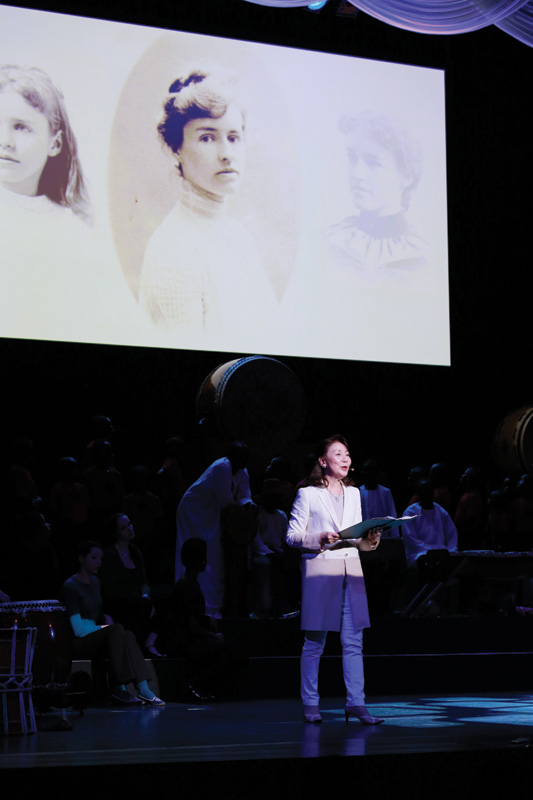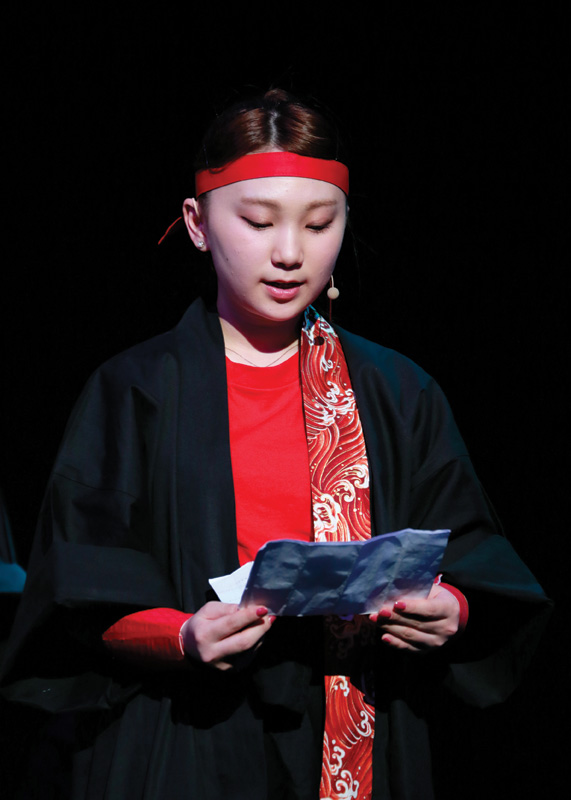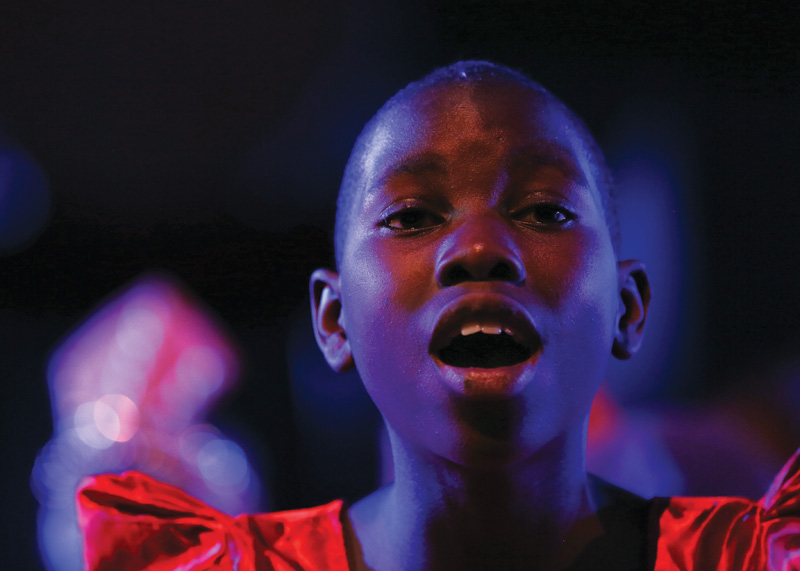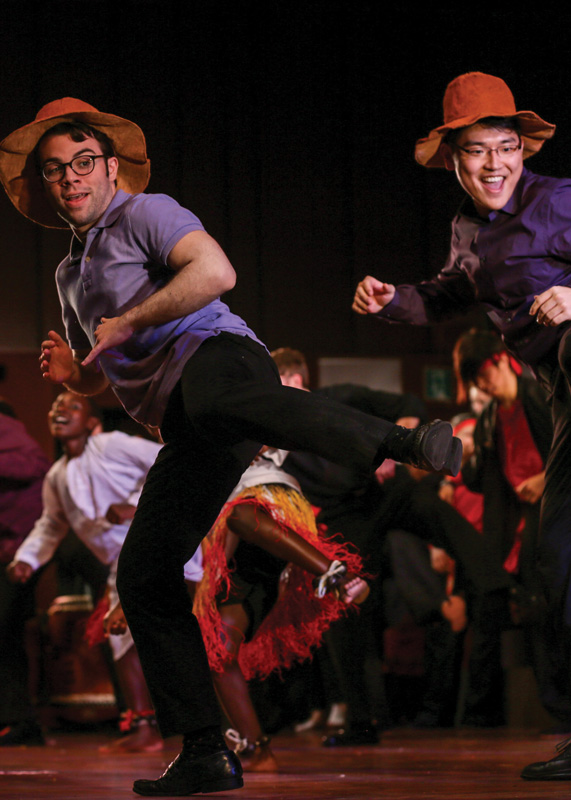It is not how most Americans would picture their first glimpse of Japan ...

Golden sunlight strikes towering mountainsides of freshly fallen snow that weighs down the surrounding evergreen boughs as our seemingly too-large bus scales narrow, icy roads ever upward. The driver is utterly nonchalant about the steep embankments with no guardrails.
Near the top of the mountain, the modern complex of the National Hanayama Youth Center provides the kind of breathtaking vista usually reserved for the quarters of well-heeled tourists. It is generally used as a summer camp for children about the age of the youngest Ugandan students. But, for us—especially those of a certain age—it seems part boot camp. There are barracks-style sleeping quarters with pillows that seem more like beanbags; short designated shower times; meal times that overlap with said shower times; and morning exercises in the gym, which, like most public spaces except for the cafeteria and (happily) our rehearsal room, is unheated.
All of this helps to create a quick bonding experience. Our students immediately connect with the Ugandan students, who wear their new coats even in the cafeteria. On the first full day, the Vassar students are outside with Ashinaga interns helping the kids enjoy the first sledding experience of their lives.
We arrive very early on a Sunday, and on Monday afternoon rehearsals begin. By then all the key players in the show are present. There’s an extraordinary Japanese taiko drumming group consisting of six professional musicians plus 13 student drummers, mostly teens. There are 30 Ugandan children, who share with the young Japanese the tragedy of having lost parents. The director, John Caird, also is here. Each group of performers has been working on its part of the show, but this is the first time they’ve all met. John’s vision has been based on commingling the three cultures with help from these young performers.

The next four days are, to put it mildly, intense. The first thing that becomes apparent is how terrific all of the performers really are. The Ugandan students dance and sing with show-stopping energy, and with even greater professionalism than they displayed in the dusty courtyard of their school’s compound when I saw them there the previous summer. Drums, a vital part of Ugandan music, are also front and center for the Japanese troupe. Our brilliant director understands that the best way to start the show is by melding these two quite distinct percussive traditions. The fife, cymbals, and drums of the taiko troupe, he insists, should be joined by the xylophone-style instrumentation and drums of the Ugandans. The result generates incredible excitement.
The stunning harmonies of the students in the Vassar choir bring power and even a certain majesty that perfectly counterbalances the Ugandans’ delicate singing of the old Shaker hymn “Simple Gifts.” Vassar’s students admirably project their voices over the taiko drums in a stirring number about a Japanese folk hero who sought help after a tsunami struck that country four centuries ago. Then there is a cascade of solos and duets by the college’s choir members that ushers in the closing number, the beautiful “Hana Wa Saku” (“Flowers Will Bloom”), a sort of “We Are the World”-style anthem written after the 2011 earthquake and tsunami struck the very area of Japan where we are rehearsing.
As we watch John integrate the disparate international elements—visual and aural—into a cohesive show, it is easy to see how he was able to stage his famous production of Nicholas Nickleby, with a cast of 38 playing innumerable characters. Each day we convene for long hours in the rehearsal room, John restlessly pacing between the performers and the tables where I sit with the English-language script I drafted to connect the musical numbers and tell the story of how alumna Jean Webster and her novel Daddy-Long-Legs inspired Yoshiomi Tamai to create Ashinaga.

With three languages being spoken, there is a constant need for reiteration and interpretation. On one side of me sits Maoko Imai Caird, John’s spouse, translating each and every alteration he and I make to the English script into Japanese so that the narrator, Mikiko Otonashi, can deliver them to the Japanese audience. The Ugandans’ teacher Emmanuel Mutubara translates John’s instructions into Luganda for his pupils. With some effort, technical director Paul O’Connor and videographer Ben Rutkowski both manage to confer with staff from the Japanese production company Ashinaga has hired to run the technical aspects of these shows.
The most difficult part of the piece, both in rehearsal and in performance, is the collection of personal testimonies of loss by both the Japanese and Ugandan children who had lost parents—especially those of the two youngest Ugandan speakers, Anitah Namuddu and Juma Nsubuga, both 10 years old. Their histories are remarkably similar: Both lost a father, then a mother to AIDS and were subsequently cared for by a grandmother, and both aspire to be doctors. Every performer who tells these stories, whether Ugandan, Japanese, or American, breaks down at some point in rehearsal, and sometimes on stage, but they are determined to go on. John is gentle and eloquent when he explains why it is important for both the performers and audiences to experience these catharses.
On the lighter side, John makes his first overt move at integrating the cultures when he has our choir members, first the young women and then the young men, join in at the end of the Ugandans’ second dance number. The Vassar crew does so with gusto, grass skirts and all. The Japanese students are initially a bit more reticent—except for the youngest, Issei Aoki, 11, who suddenly seems to think he is part of the Ugandan troupe. (By the time of our second show in Tokyo, a week after our Sendai performance, all of the Japanese students will be dancing with abandon.)

Cappy and other top Vassar administrators make the trek up the snowy mountain the night before our initial performance to watch our first complete run-through. The feeling in the room is electric. Our new friends from Uganda and Japan are thrilled when Cappy distributes Vassar sweatshirts to every one of them. From that moment on, in rehearsal, that’s pretty much what every Japanese and Ugandan performer wears.
The first performance of At Home in the World takes place in Sendai, capital of the region hardest hit by the 2011 earthquake and tsunami, two days after the third anniversary of that tragedy. The concert hall, which holds about 1,200 seats, has been completely filled by those fortunate enough to get the tickets offered by Ashinaga. Among the audience, sitting with Ashinaga’s president Tamai, President Hill, and Vassar Board of Trustees Chair William A. Plapinger ’74, is Prince Akishino, second in line to the Emperor.
The taiko and Ugandan drummers rock the house to a fever pitch of excitement. Later, the Ugandan children dance for a thousand people without any sign of stage fright. The Vassar choir, singing right after Anitah and Juma’s testimonies, brings the house to tears singing a lovely requiem. Ben Rutkowski’s video, showing the damage caused by the Great East Japan Earthquake and Tsunami, plays in the background as Maria Kusaka, a Japanese teenager from the region, recounts the loss of her father in the 2011 tragedy. And the American students strike a deep chord with everyone present as they begin “Hana Wa Saku.” The Ugandans and the Japanese on stage, and the Japanese in the audience, soon join them.
At John’s request, I have added an extra paragraph to the narration at Sendai, thanking Ashinaga for its extraordinary work and for making the concert possible, and acknowledging all that Vassar has contributed to the show. As the narrator finishes saying these lines, a woman sitting next to me wearing a gorgeous gold kimono turns and says graciously, “Arigato, Vassar daigaku.” (“Thank you, Vassar College.”)

Lance Ringel, a senior staff writer at Vassar College, was among a group of Vassar administrators who were guests at Ashinaga’s Rainbow House in Uganda during the summer of 2013. His knowledge of Japanese language and culture made him an informed collaborator on the At Home in the World production. In 2011, he lent his scriptwriting prowess to Vassar Voices, a staged production that celebrated Vassar’s 150th anniversary.
